Among the variety of anti-aging procedures presented today, peelings occupy a special place, one of which is the Jessner chemical peel or, as it is also called, “Hollywood.”
Jessner peeling is one of the most popular due to its effectiveness, variations in application, relative safety and rapid restoration of the epidermis.
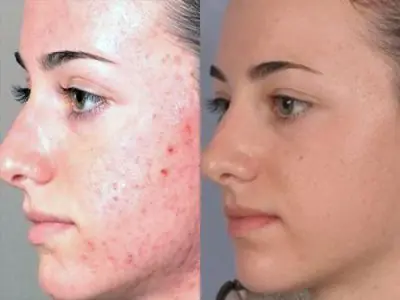
Jessner peel before and after photos
Jessner's peel was originally intended as an antiseptic, in the form of an aftershave lotion, to prevent the spread of infection among crew members on one of the American submarines.
Max Jessner, who served as a doctor on this submarine, combined the simplest ingredients available at that time, resulting in a unique product that not only had excellent disinfectant properties, but also qualitatively improved the appearance of the skin.
What is a Jessner peel?
Jessner's peel is a three-component mixture in equal proportions: salicylic acid, lactic acid and resorcinol. In some cases, ingredients such as glycolic or citric acid and isopropyl alcohol may be added for effectiveness.
- Salicylic acid - presented in the composition with a concentration of 14%. It has an antiseptic, anti-inflammatory, keratolytic and mild drying effect. Reduces the secretion of sebaceous glands, promotes epithelization of skin defects, relieves inflammation and itching.
- Lactic Acid, concentration in peeling - 14%. It has a whitening, exfoliating and moisturizing effect, promotes the production of collagen and elastin.
Unlike fruit acids (also included in alpha hydroxy acids), lactic acid has a gentle, gentle effect on the skin, allows it to retain and evenly moisturize the various layers of the epidermis, which makes it one of the most important components of the Jessner peel.
- Resorcin (Resorcin) – also presented in the peeling composition with a concentration of 14%. It has antibacterial, whitening, astringent and cauterizing effects, enhances the effect of the above components.
Thanks to this proportional composition, the action of Jessner peeling is aimed at eliminating excessive skin greasiness, hyperkeratosis (exfoliating cells), and smoothing out wrinkles.
Jessner peeling can have different effects, and depending on the number of layers applied and the duration of action, it can be:
- Surface. In this case, the mixture is applied once. After this, redness of the skin is observed, followed by peeling of the stratum corneum. This effect can be a preparatory procedure for medium or deep peeling.
- Median. Apply two or more layers. The effect is on the entire layer of the epidermis, up to the basement membrane, but without affecting it. In this case, there is a strong redness of the stratum corneum, followed by the formation of a dense film or even a crust, which tightens the skin, and after a few days begins to peel off.
The effects that are deeper than the basement membrane are deep chemical peels, but “Hollywood” is used extremely rarely for such effects.
In any case, the type of peeling is chosen individually by the cosmetologist, depending on the condition of the skin and the type of problem being solved.
Indications for Jessner peeling
Hollywood peeling, once obtained experimentally, is aimed at renewing/rejuvenating facial skin, and more precisely, at:
- elimination of increased greasiness
- elimination of pimples and acne, up to complete elimination
- elimination of hyperkeratosis
- smoothing out fine wrinkles
- getting rid of pigmentation
- improved blood circulation
- renewal of cellular tissue and restoration of skin elasticity
- increasing skin elasticity and firmness.
That is, in essence, the lifting effect of Jessner peeling is similar to the action facial mesotherapy or other rejuvenating procedure.
Pros and cons of the Jessner peel
- Safety. Unlike similar procedures, the likelihood of side effects from Jessner peeling is negligible - scars and areas of post-peel pigmentation are practically eliminated, this is explained by the ability to control the process of the procedure.
- Versatility. Depending on the number of layers and exposure time, you can get: superficial, superficial-medium and medium peeling.
- Efficiency. Jessner peel is an effective treatment for problematic and acne-prone skin. Thanks to the balanced composition of the drug, the amount of acne and its consequences decreases with each procedure performed.
- Active exfoliation. The uniform application of the drug mixture promotes uniform and active exfoliation, which, according to experts, leads to good results.
- Fast rehabilitation. Superficial Jessner peeling does not require long-term post-peel care or a large number of procedures, allowing you to return to your normal lifestyle in the shortest possible time.
The disadvantages of the procedure are predictable, but quite tolerable, these are:
- painful procedure
- unpleasant chemical smell
- the mixture can be toxic because salicylic acid and resorcinol react with oxygen.
If stored for a long time and improperly, the Jessner peeling composition loses its properties: it must be stored in a cool place, in a dark container with a tightly screwed lid.
Indications and contraindications
The use of Jessner peeling is relevant for the following skin problems:
- increased skin greasiness
- hyperkeratosis (thickening of the stratum corneum)
- scars
- pigmentation, freckles
- ingrown hairs
- skin aging, appearance of fine wrinkles
- acne, acne, post-acne
- enlarged pores, comedones.
Despite the relative safety of the procedure, the Jessner Peel has numerous contraindications, such as:
- allergy to one of the components of the drug
- pregnancy and lactation
- diabetes
- oncological diseases
- autoimmune diseases
- hypersensitive skin
- fungal infections and acute diseases, including: herpes, dermatoses, trichophytosis, microsporia,
- papillomavirus in the form of large moles
- purulent-inflammatory processes: boils, impetigo
- the presence of damage to the skin such as: inflammation, wounds, cracks
- rosacea
- sunburn
- elevated body temperature
- long-term use of certain medications for the treatment of acne - therefore, a consultation with a cosmetologist is necessary before the procedure
- chemotherapy period
- demodicosis - Jessner peeling can provoke an exacerbation.
Due to active insolation, it is not recommended to perform Jessner peeling in the spring-summer period and in the summer.
Patients with dark skin are recommended to undergo a test for individual tolerance of the ingredients before the procedure.
Performing a Jessner peel
In some cases, preliminary preparation is necessary before performing a Jessner peel. Depending on the problem, its options may vary, from one or two peelings in a beauty salon to the use of fruit acids at home.
But basically it is enough to use a special lotion and apply sunscreen in the morning. In any case, the quality and duration of preparation for the procedure is decided individually with the cosmetologist at the first consultation.
IMPORTANT: On the day of the Jessner peel, it is not recommended to use moisturizing creams or cosmetics based on fruit acids.
Immediately before the session, it is necessary to conduct a test for the reaction of the drug; for this, a peeling mixture is applied to a delicate area of the skin (behind the ear, on the bend of the elbow) for 5 minutes. In case of severe redness or itching, the procedure is not performed.
The Jessner Peel procedure begins with cleansing the skin. Special products with PH 4.5 - 5.5 are applied to its surface with light massage movements, after 30 seconds. washed off with water. Then the skin is degreased with alcohol.
And only after this, the mixture is consistently carefully applied from top to bottom, i.e., starting from the forehead to the chin, and lastly on the eyelids.
After a couple of minutes, the skin is covered with a coating of white crystals of salicylic acid, which are an indicator of uniformity of application. An unpleasant burning sensation is accompanied throughout the entire procedure.
The Jessner Peel can be applied in two to four layers, spaced 5 minutes apart. The skin's reaction is assessed immediately after each application, which determines the number of layers and depth of penetration required to achieve the desired effect.
At the end of the procedure, the Jessner peeling mixture is not washed off, a special moisturizer and a soothing mask are applied to the skin.
And only after four to five hours, and according to some reviews - six, you can wash off your face at home yourself. In case of a strong reaction, the peeling mixture is removed immediately. After washing, it is recommended to apply Panthenol ointment to the skin.
Post-peeling rehabilitation
The condition of the skin the next day depends on the duration of exposure and the number of layers applied: from mild redness and swelling to a feeling of severe burning/pain, intense redness and a feeling of excessive tightness.
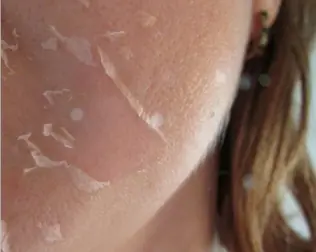
As a rule, exfoliation begins on the third day and lasts for five days. According to some reviews, again depending on the type of skin, pain threshold, number of layers applied - for some, the peeling process goes almost unnoticed, they have the opportunity to go to work and visit public places.
For others, it’s the opposite (as evidenced by photographs) - the face becomes covered with dark spots, the skin is tightened to the point of feeling like a shell, where pain and burning are replaced by severe itching.
The film that appears should never be removed by force, otherwise it can lead to an unhealthy skin color with pink spots. Only self-exfoliation of the film guarantees the achievement of the desired effect: tightened, uniformly smooth, without wrinkles, dark spots and comedones - young, delicate skin.
The number of Jessner peeling procedures is prescribed individually, depending on the condition of the skin and existing problems. Basically, these are from 5 to 8 sessions every four to six weeks, and each subsequent procedure may be less gentle, and again, it all depends on the individual characteristics of the patient.
The skin restoration process, as a rule, lasts 7-9 days, but it can be significantly shortened if you wash your face with thermal or acidified boiled water several times a day and carefully treat the skin with Panthenol ointment.
Ideally, a Jessner peel procedure should be scheduled in advance so that you can take care of your facial skin and be in a state of physical and psychological peace.
During the post-peeling rehabilitation period it is recommended:
- stop using makeup
- refuse to visit the solarium
- use sunscreen and spend less time in the sun.
Consequences of the Jessner Peel
When applying a Jessner peel, like any other chemical effect, there is a burn of the skin followed by rejection of the stratum corneum, which can lead to both expected and unexpected consequences.
Expected Consequences. This is usually a natural reaction of the skin to external irritants, in this case chemical ingredients. Such consequences are observed in almost everyone, these are:
- Erythema. Or redness of the treated area; after Jesser peeling, it lasts up to three days.
- Swelling. Or the reaction of the vascular system is observed on the second day, and can persist for up to three to four days. Therefore, in order to avoid obvious swelling, it is very important to take into account the characteristics of the patient’s skin, the duration of exposure to the Jessner peel, and the amount of applied
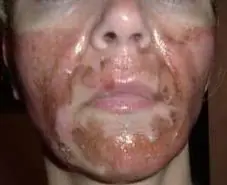
skin condition after the procedure
layers.
- Dark spots. In some cases, darkening of the skin may occur, which disappears after 6-7 days. Depends on the individual characteristics of the skin.
- Peeling. The natural reaction of the skin to chemical exposure, in this case, the Jessner peel.
- Hypersensitivity. Renewed skin after peeling is tender and sensitive, which is quite natural.
Unexpected consequences. If certain conditions and hygiene rules are not observed when applying a Jessner peel, complications may occur that can have a very negative impact on the appearance and health of the patient.
- Infection. Failure to comply with antiseptic rules when using Jessner peeling can be fraught with various infectious complications, such as streptostaphyloderma or herpes. Treatment will require the use of antibiotics and ointments.
In case of earlier relapses of herpes, it is necessary to warn the cosmetologist to take prophylactic antiviral drugs, since skin stress caused by peeling can “awaken” the latent state of the virus and provoke a complication.
- Allergy. When using the Jessner peel, it is observed quite rarely. To avoid such problems, a preliminary test is carried out. However, in normal conditions, the peeling ingredients may not have the desired effect, but the renewed skin after peeling is especially vulnerable, and a reaction in the form of swelling and severe itching can be triggered by any irritants.
How much does a Jessner peel cost at a salon?
The cost of a Jessner peel is determined by the geographic location of your city, the category of the beauty salon, the qualifications of the cosmetologist and the brand of the drug used.
Therefore, the cost of one procedure can vary from 2,000 to 6,000 rubles. The cost of the course is determined by the number of procedures prescribed.
Is it possible to perform a Jessner peel at home?
Yes, you can if you wish. Since all of the listed ingredients are sold in pharmacies, no prescription, special knowledge or special equipment is required.
However, without certain experience, appropriate knowledge about the characteristics of the skin and, possibly, serious contraindications, you can cause serious injury to the skin of the face.
Only a professional can foresee all the nuances of the procedure and prevent any negative consequences.
In addition, practicing cosmetologists for Jessner peeling prefer ready-made preparations from such global manufacturers as: MedicControlPeel (Russia), Allura Esthetics (USA), MedPeel (USA), PCA Skin (USA), Natura Bisse (Spain), Mediderma (Spain) , NanoPeel (Italy), Enerpeel (Italy).
Modern cosmetology offers a wide range of cosmetic procedures with varied effects. One of the most effective procedures for removing the stratum corneum of facial skin is peeling. The demand for this procedure lies in the possibility of obtaining a good and lasting effect. Peeling makes the skin surface even, smooth, improves complexion, removes age spots, renews the epidermis and successfully fights acne.
What is peeling
Peeling (exfoliation) – exfoliation of the upper stratum corneum to improve the appearance of the skin. By removing dead cells from the surface of the skin, it becomes young and soft.

We can say that peeling is the deliberate traumatization of the skin with special chemical solutions in order to trigger the forced regeneration of skin processes. This is a planned burn that allows skin cells to divide and renew themselves with renewed vigor. The skin is constantly undergoing processes of renewal and restoration. At a young age, these processes occur quickly and efficiently, but over the years they slow down. Peeling helps speed up these processes. Since peeling disrupts the integrity of the skin, some complications are possible. They can harm a woman’s health and negatively affect the final result of the procedure. Why do complications occur? Let's look at this below.
Causes of complications after peeling
Complications after chemical peeling are divided into:
Predicted complications are expected complications that are inevitable during invasive manipulations. They arise as a result of the body’s normal reaction to skin trauma (chemical, mechanical or other action).
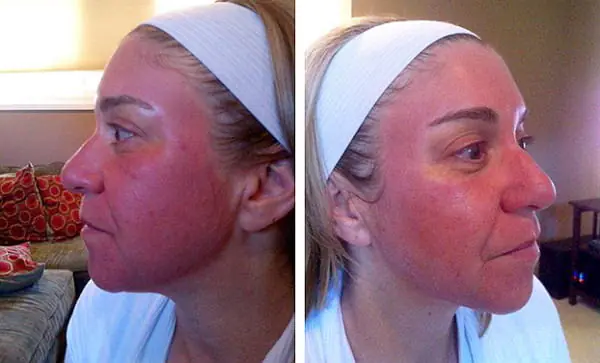
Erythema, which is persistent severe redness of the treated area. The severity and duration of its persistence depend on the aggressiveness of the technique. This complication often occurs in people with enlarged vascular networks on the face after deep peeling.
Unpredictable complications are unforeseen complications that, in principle, should not exist, but, unfortunately, they do happen. Often the cause of such complications is the doctor’s unprofessionalism, violation of the rules of asepsis and antisepsis by both him and the patient, violation of peeling techniques, and the cosmetologist’s erroneous determination of the initial condition of the skin: its thickness, phototype and sensitivity.
A series of complications is associated with the one-sided approach of the cosmetologist to the selection of patients for one or another peeling method, as well as to the one-sided management of pre- and post-peel measures.
Very often complications arise due to the fault of the patients themselves. Violation of the schedule of post-peeling activities will negate the effect of the procedure. The most common violations by patients include failure to comply with the cosmetologist’s prescriptions: exposure to the sun and ultraviolet irradiation, forcible removal of scabs, and giving up bad habits. The patient’s serious and responsible attitude towards post-peeling measures contributes to the rapid completion of the rehabilitation period.
The patient's health status at the time of peeling and the combination of different therapy methods can cause complications after exfoliation. For example, the patient does not inform the doctor about the presence of a concomitant disease or about the therapeutic treatment carried out during this period. In this case, any invasive intervention in the body can give an unexpected result.
For example, the use of hormonal drugs during the procedure may increase the risk of excessive hyperpigmentation. Pathological processes of the genitourinary system also contribute to the persistent development of hyperpigmentation, and peeling will not help here, but will only aggravate the problem. Performing deep peels and using the retinoid isotretinoin (a drug that contains vitamin A) can affect the healing process of scars.
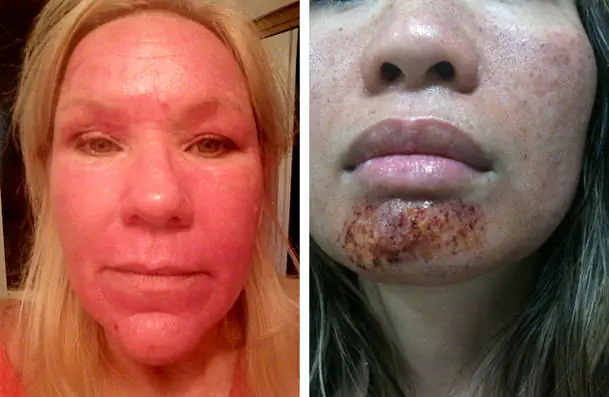
Complications. occurring after laser exposure: 1. Erythema and swelling of facial tissues on the 6th day after laser dermabrasion 2. Point hemorrhages from damaged small vessels with the formation of small hematomas after the Fraxel laser.
Unpredictable complications include individual characteristics of the body. In this case, it is very difficult to predict possible side effects and complications. Since everything directly depends on the genetic characteristics of the skin, the body’s metabolism and the patient’s lifestyle.
Bad habits affect the progress and complications of the peeling procedure. For example, the presence of such a bad habit in a patient as smoking contributes to pathological scarring of tissue, and recovery after any cosmetic procedures is much more difficult for them.
Exfoliation is carried out using various chemical agents, as well as their combinations. For this reason, each exfoliation method has its own mechanism of action, as well as possible complications and side effects. For example, the use of phenol as a chemical agent can provoke poisoning, so you need to correctly take into account its concentration, remembering its high toxicity.
To summarize, let’s say that there are a number of objective reasons due to which one cannot be completely insured against complications. This depends on the effect of chemical agents on the skin, that is, the more aggressive the technique is chosen, the more serious the complications after peeling can be.
Let's once again name the reasons that cause side effects and complications after exfoliation:
- violation of the integrity of the skin;
- individual characteristics of the skin and body;
- features of the methodology;
- lack of professionalism of the doctor and irresponsibility of the patient;
- general health of the patient.
It should be recalled that before carrying out any procedure, a competent specialist will necessarily collect an anamnesis regarding the patient’s health condition, prescribe laboratory tests, and, if necessary, consult with related specialists.
Side effects after exfoliation
We wrote above that there are predictable side effects that always occur in cases of invasive intervention in the body. These are temporary phenomena. They should not cause concern, as they do not harm the body and disappear within a couple of days after the procedure. Usually this:
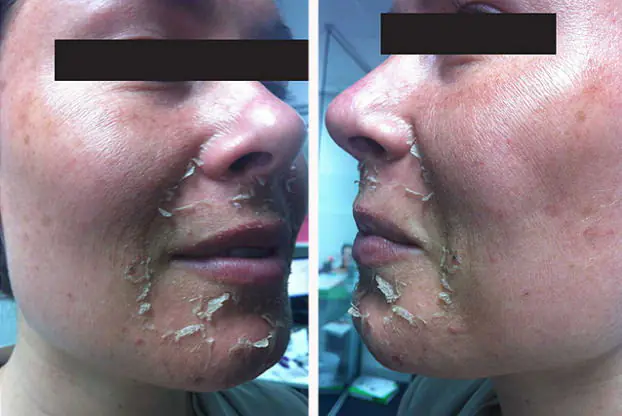
Peeling is the basis of the peeling mechanism as such. It is a common consequence and goes away within 1-3 days. However, after using trichloroacetic acid or resorcinol, large scaly peeling may occur and persist for a week or longer.
- moderate hyperemia;
- erythema (severe redness of the skin);
- peeling of the skin;
- swelling;
- crust formation.
Skin hyperemia is a normal skin reaction to chemical agents. It occurs due to damage to the skin, and its intensity depends on the degree of aggressiveness of the chemical.
In cases where the patient violates post-peeling measures, prolonged and persistent skin erythema is possible.
Peeling of the skin after the procedure also depends on the degree of aggressiveness of the chemical, the technology used and timely rehabilitation. For example, after superficial peeling, peeling is almost unnoticeable, after medium peeling, peeling is observed with the formation of thin brown crusts, and after strong peeling, peeling is widespread and pronounced with the formation of deep crusts. In different areas of the skin, peeling has different intensity, which is associated with the thickness of the epidermis and the number of sebaceous glands.
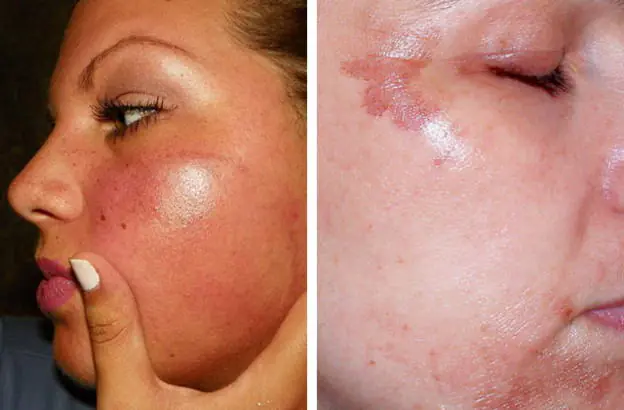
Hyperpigmentation occurs when there is an inadequate cellular response and excessive melanin production by cells, resulting in dark areas. This most often occurs after treatment with trichloroacetic acid or exposure to a laser beam.
Edema is a peculiar reaction of the skin to external irritants. After peeling, the permeability of the capillaries increases, fluid leaves them and accumulates in the tissues, thereby causing swelling.
Complications that arose during the post-peeling period
These complications can occur both immediately and some time after peeling. They differ from ordinary side effects in that they have an extremely negative impact on the aesthetic result, and in some cases even pose a health threat and require urgent medical intervention.
Complications are as follows:
- allergic reaction;
- persistent erythema;
- marbling of the skin;
- hyperpigmentation;
- exacerbation of acne;
- demarcation line;
- hypertrophic and keloid scars;
- fibrosis of the dermis;
- formation of atheromas (sebaceous gland cysts).
To avoid a slow or immediate allergic reaction, a cosmetologist should prescribe skin tests before the procedure. Sometimes the patient himself does not know that he is allergic to any substance, and this is fraught with serious consequences in the form of anaphylactic shock.
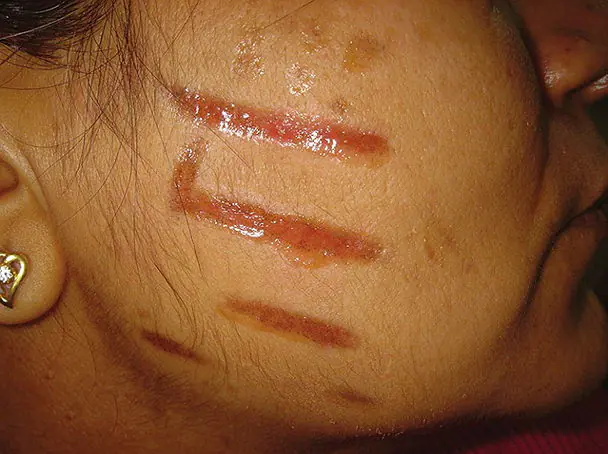
Hypertrophic and keloid scars are treated with combined methods - surgery, cryotherapy, steroid drugs, laser resurfacing, etc.
A complication such as marbling of the skin occurs due to the death of specialized cells called melanocytes, which are responsible for the production of melanin in the body. This problem occurs most often in women with dark skin. But the problem is that this defect cannot be corrected; you can only slightly even out the tone with the help of additional superficial peels.
Hyperpigmentation is persistent dark coloration of the skin. In some cases, pigmentation is long-lasting and persistent, but this is not always a complication after peeling. Sometimes adult skin reacts this way, and this is most often associated with the individual characteristics of the body or with hormonal imbalance. If this is an individual feature of the skin, then there is no reason to worry. But in case of hormonal imbalance, specialist advice is needed to identify the causes of this symptom. A cosmetologist must identify the true cause of hyperpigmentation to determine a further strategy.
Strange as it may seem, such an unpleasant skin defect as acne, which is successfully eliminated by peeling, in some cases may intensify after the procedure. And the reason for this, first of all, is the inflammatory process, which encourages the sebocyte cells responsible for the formation of sebum to work actively. Those at risk include those with oily skin, chronic seborrhea and acne. If the inflammation intensifies, treatment is carried out with antibiotics and anti-inflammatory drugs.
The demarcation line is a very unpleasant complication. This line clearly delineates the treated and untouched areas of the skin. This happens mainly in patients with porous and dark skin. This defect can only be removed with the help of additional gentle peeling.
The appearance of keloid and hypertrophic scars is the most serious and difficult to correct complication after exfoliation. Scars appear as a result of violations of peeling technology, when combining deep peeling and other cosmetic procedures, with a tendency for fibrous connective tissue to grow, as well as when forcibly removing crusts in the post-peeling period. To eliminate this problem, serious medical treatment is needed, but, unfortunately, the nature of keloid scars has not been sufficiently studied, and there is no effective method that could guarantee the complete absence of relapse.
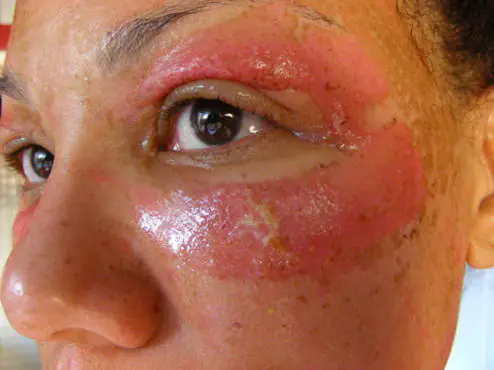
1. Formation of blisters filled with serous fluid 2. Prolonged redness and swelling of the tissues of the periorbital area
Skin fibrosis occurs when the basement membrane is destroyed during the peeling process. At the same time, the texture of the skin changes, and instead of fine and shallow wrinkles, deep and rough furrows form.
A sebaceous gland cyst (atheroma) appears as a result of mechanical disruption of the sebaceous gland ducts after deep peeling. As a result, the outlet becomes smaller and the outflow of sebum slows down. Atheromas can only be removed surgically, with the removal of the sebaceous capsule.
Rehabilitation actions in the post-peeling period
As a result of the removal of the upper protective layer of the epithelium, the skin becomes very vulnerable. After all, in fact, one layer of skin was removed. For this reason, you need to take care of her during this period with a double layer, following all the recommendations and prescriptions of the cosmetologist. Also, the range of post-peeling procedures depends on the depth of damage to the skin. What does it mean?
- With superficial peeling within the stratum corneum, no special care is required. You can continue traditional skin care using sunscreen and restorative products;
- for medium peeling without damaging the basement membrane, use broad-spectrum sunscreens with a high SPF (sun protection factor). Sunscreens should contain both physical and chemical filters, as well as protection against both UVA and UVB rays. How do sunscreens work? They prevent the penetration of rays harmful to the skin, thereby blocking the synthesis of melanin and the formation of hyperpigmentation;
- with deep peeling, which damages the destruction of the basement membrane in addition to the above-mentioned actions, antiviral and antibacterial drugs, anti-inflammatory drugs and procedures are used to improve metabolic processes in the skin and stimulate its rapid regeneration.

If you decide to undergo peeling, you should be prepared for the fact that this procedure is not without consequences. You will have to adhere to certain lifestyle restrictions for some time. The recovery period varies in duration and severity of side effects, depending on this, be patient and strictly follow the instructions of the cosmetologist.
It is sometimes impossible to avoid complications and side effects due to the unpredictable behavior of the body when its clear and coordinated work is interfered with.
Therefore, choose a clinic carefully, and most importantly, make sure that you can completely trust the professional level of your cosmetologist. Beauty, of course, requires sacrifice, but it would be unforgivable if it were human.
For deep skin renewal in the shortest possible time, cosmetology uses acid peels. They come in different types and chemical compositions, and in this article we will talk about one of the most common peels - the Jessner peel.
What it is
According to legend, it was named after a sailor named Jessner, who was the first to think of mixing together the acids used in the procedure. This was done to protect deck mates from the raging viral epidemic on the ship.
Chemical peeling is called because of its composition. Chemists mix salicylic and lactic acids in equal proportions (14% each) and add resorcinol. These ingredients tend to penetrate deep into the skin.
The resulting drug is applied to the skin, causing slight or heavy peeling - this depends on the percentage of acids in the composition. This reaction is explained by increased skin renewal - its layers are deliberately destroyed in order to subsequently enhance the production of collagen and elastin, reduce the secretion of sebum, reduce the visibility of pores and have a pronounced antibacterial effect. The keratinized layer of cells is eliminated, the skin becomes irritated and red, and then fresh, healthy and smooth skin appears in place of the peeling.
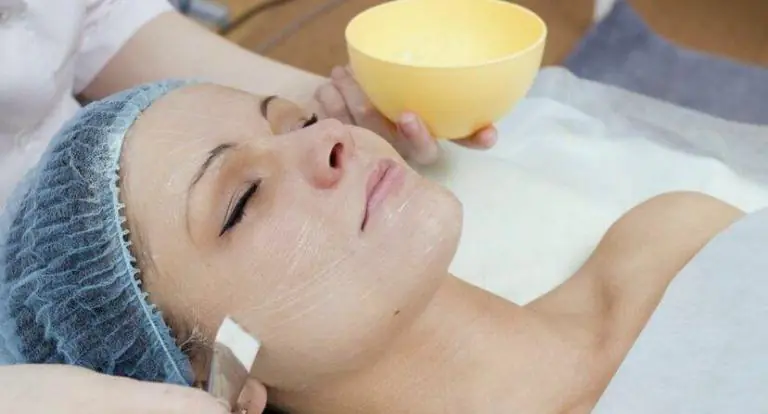
The result of a Jessner peel depends on the number of layers of the drug used applied to the skin. So, 1-2 layers will give the effect of superficial peeling - the skin will turn red, small white “flakes” of dead cells will form on it, the result will not affect deep scars and spots.
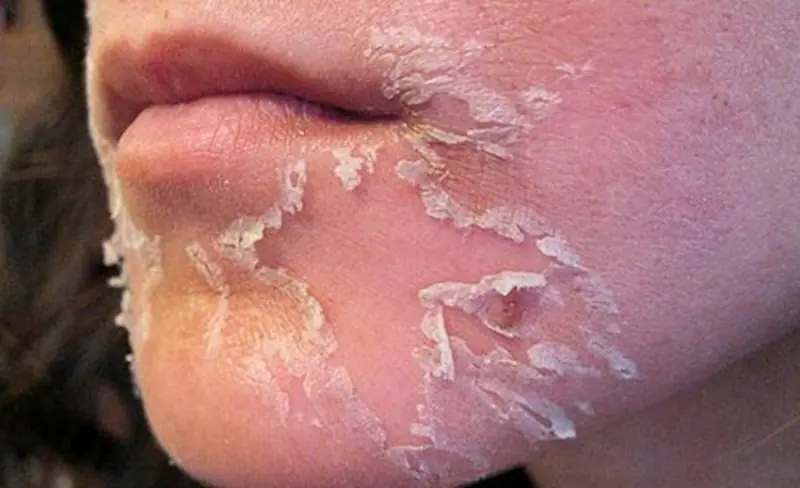
Application in 3 and 4 layers gives the most pronounced effect of medium peeling. The skin actively peels off, and subsequently the clients’ pigmentation spots turn pale or disappear completely, and small wrinkles and scars are smoothed out.
Deep peeling of the skin is performed extremely rarely, often for medical rather than cosmetic purposes. Applying more than 4 layers of acid at one time can cause burns and irreparable injuries to the skin.
Any acid peels, except superficial ones, can only be carried out by a dermatocosmetologist who has received a medical education and completed the appropriate courses.
How does the procedure work?
Before peeling, some specialists perform a superficial peel with a reduced acid content (for example, almond peel). This will help predict how your skin will react to stronger treatments. After that, after at least 10 days, they begin Jessner peeling.
First, the skin is cleansed of makeup and dirt. Afterwards, a layer of acidic preparation is applied to the face, wait up to 5 minutes, and then wash off the layer, which causes the most unpleasant sensations. If a more pronounced effect is required, the product is applied again up to 4 times. Many patients note a pungent alcohol odor from acids, which is normal.
After some time, the chemical mixture is washed off with water and a healing ointment is applied. Somewhere it’s Panthenol and analogues, somewhere it’s regular baby cream. Sometimes the specialist sends the patient home with facial peeling. In this case, after about 6 hours, you need to wash off the acids yourself with water without cleansing cosmetics.
You can watch the video, which breaks down the main aspects of the Jessner peeling in the salon.
Indications and contraindications
Indications for Jessner peel:
- Hyperpigmentation (sun spots, freckles and acne);
- Skin laxity and wrinkles;
- Excessive oiliness of the sebaceous glands;
- Skin prone to rashes;
- Roughness, porosity of the skin.
Jessner peel is not recommended for use by people with healthy skin. If you have minor imperfections such as a few spots and wrinkles, try mild acid treatments (such as almond peels) to improve the overall appearance of your face.
Contraindications:
- Acne, demodicosis in the active stage;
- Herpes and other active infections;
- Postoperative period;
- Diabetes and other diseases of the endocrine system;
- Intolerance to peeling components;
- Pregnancy and lactation;
- Treatment with systemic retinoids at the time of procedure;
- The presence of fresh wounds on the skin.
Photos before and after the procedure
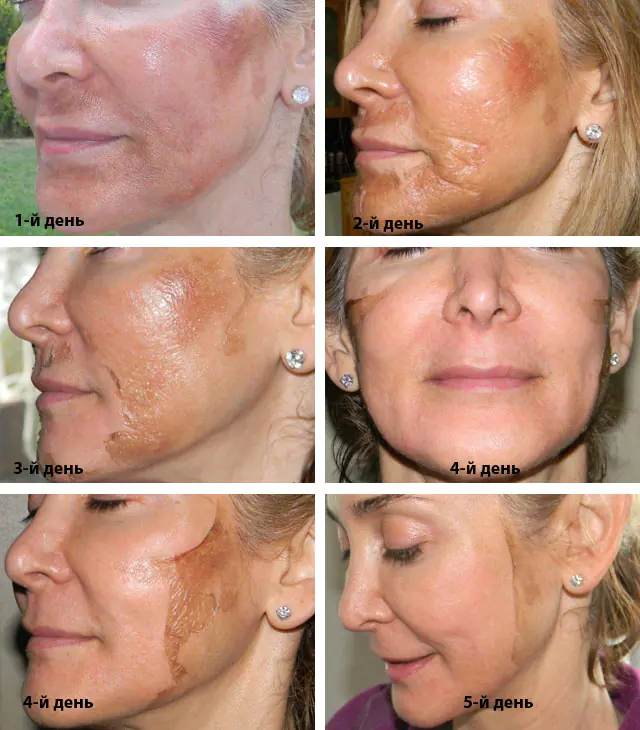
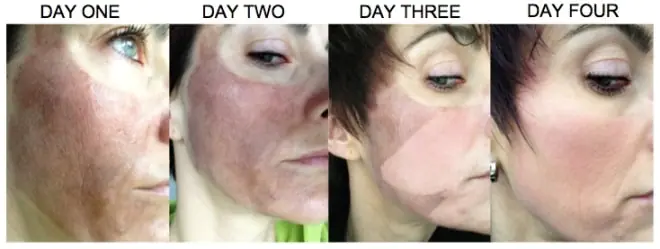
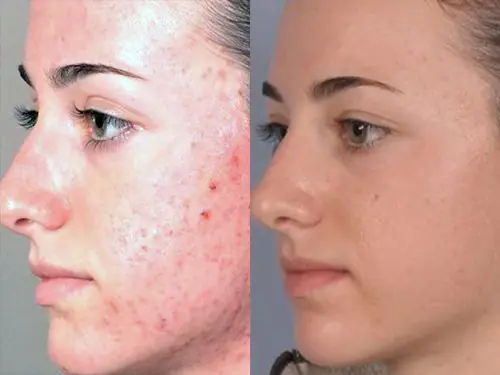
How many procedures are needed and how often can they be done?
For visible, but small results from Jessner peeling, one procedure is enough. However, after completing a course of 5-8 peels, the deepest forms of pigmentation and wrinkles are eliminated. The procedure can be repeated only after complete restoration of the skin!
The frequency of Jessner peels depends on the client’s age (the younger he is, the faster the tissue is restored, which means it is possible to exfoliate the skin more often). The average interval between peels is from 10 days to 2 weeks.
Procedure at home
It is not recommended to perform a Jessner peel on your own unless you have knowledge and experience in cosmetology and have never done an acid peel on yourself.
However, if you wish, you can purchase a bottle of the necessary acids at a professional store. When choosing a chemical composition, focus on a small percentage of acids - this way you can practically understand how much your skin needs.
Ideally, to better understand the essence of the procedure and your skin’s reaction to it, you should visit at least 1 peeling in the salon. You will be able to observe the actions of a professional to avoid mistakes at home.
In addition to the bottle of acids itself, purchase a healing cream for post-peeling care and in case of serious burns. These can be either classic professional ointments (Panthenol, Dexpanthenol, etc.) or creams from luxury brands (BIODERMA Cicabio Creme, LA ROCHE-POSAY Cicaplast, etc.). Study articles and videos about the Jessner peel, and then begin the procedure at home.
Below is a video that describes in detail examples of care products that will help with recovery.
Consequences of an illiterate procedure
The troubles that are most often encountered after a Jessner peel are redness, peeling, tightness, dryness and slight swelling. This is normal for such a strong acid peel - the effects disappear within a week.
However, if a cosmetologist or the person who performed the procedure at home makes a mistake, the following complications may occur:
- New rashes. Unaccustomed exposure to acids may cause the skin to become inflamed. When a client develops open and closed comedones and various forms of acne, he is prescribed non-aggressive treatment;
- Burns. After the procedure, the client will experience a mild or moderate form of burn in one way or another. Anything more comes from a large number of layers of the product applied on the skin (more often in the case of deep peeling). The patient is prohibited from aggressive washing and is prescribed healing ointments;
- Exacerbation of infection. This happens if the patient does not notify the dermatocosmetologist in time about his diseases in an active form (herpes, demodicosis, etc.). Before starting the procedure, you need to recover, and if the disease is chronic, then wait until the infection subsides and take medications that contribute to this.
Post-procedure care
Care after any acid peel is aimed at healing the skin and protecting it from the sun.
Immediately after the last layer of the Jessner peel is removed, a healing ointment or baby cream is applied to the client's face. It is recommended to travel home by car or taxi to minimize skin interaction with the sun and the environment.
It is forbidden to wash your face or touch your face in any way for 12 hours after peeling. Washing the next day is allowed. Taking a shower and lightly massaging your face can speed up the process of exfoliating dead particles. It is not prohibited to use foam cleansers for dry skin. Be sure to use healing care products throughout the day.
Do not manually pick off pieces of dead skin. You will only slow down its healing, and in the worst case, leave wounds and spots on your face.
Decorative cosmetics can be used approximately 11 days after peeling, but only if there is no obvious damage to the skin. Patients note that cosmetics adhere better to fresh skin after acids.
You also need to remember about sun protection. This applies not only to post-peeling care, but to life in general. Apply the product with patting movements in a thick layer. This should be done 20 minutes before going out into the sun. The recommended amount of sun cream for just one face is about 1.25 ml. Buy yourself a measuring spoon to find out how much you need. Its spf should be at least 30.
Update your Sanskrin every 2 hours you are outside. You don't need to wash your face first for this. Remember that not wearing sun protection will cause new wrinkles, hyperpigmentation and freckles that you fought with the Jessner peel.
Prices in the Russian Federation
Throughout Russia, Jessner peeling enjoys well-deserved popularity. Due to the location of the country in the north, it is easier for people to undergo skin restoration, because the absence of high UV radiation does not worsen the condition of the burns received.
The price tag for the procedure is also considered attractive. At the end of 2017, the price for peeling in Moscow and St. Petersburg ranges from 3,000 to 6,000 thousand rubles. The average price for most salons is 4,500 rubles. It does not include a preliminary consultation with a cosmetologist.
It is noteworthy that for the same amount or even less you can purchase a ready-made bottle of Jessner acids. You can take a risk and try the procedure yourself, but be aware of the consequences. If you leave the mixture on for an extra few minutes, you can get severe burns and be left with deep scars on your face forever.
Reviews of this peeling in the salon are often positive. Girls note the quick results and low price for one procedure, as well as a tolerable recovery period. It is most often carried out in the autumn-winter period to minimize skin exposure to the sun.
Thus, the Jessner peel, like other acid treatments, has a number of pros and cons. Having assessed the seriousness of the procedure and aftercare, as well as being informed about possible complications, you can try peeling for yourself. If you take the matter seriously, you will see a clear result regarding the beauty of your skin after just a few procedures!



